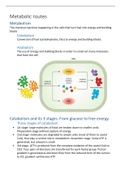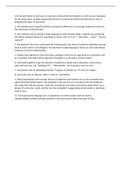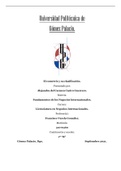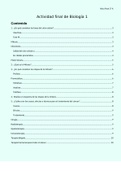Metabolic routes
Metabolism
The chemical reactions happening in the cells that turn fuel into energy and building
blocks
Catabolism
Conversion of fuel (carbohydrates, fats) to energy and building blocks.
Anabolism
The use of energy and building blocks in order to construct many molecules
that form the cell
Catabolism and its 3 stages. From glucose to free energy
Three stages of catabolism
• 1st stage- large molecules of food are broken down to smaller units.
Preparation stage without capture of energy.
• 2nd stage- molecules are degraded to simple units (most of them to acetyl
CoA), that play a central role in metabolism. Anaerobic stage. Some ATP is
generated, but amount is small.
• 3rd stage- ATP is produced from the complete oxidation of the acetyl CoA to
CO2. Four pairs of electrons are transferred for each Acetyl group. Proton
gradient is generated as electrons flow from the reduced form of the carriers
to O2. gradient synthesizes ATP.
Glycolysis
,
, CO2. Four pairs of electrons are transferred for each Acetyl group. Proton
gradient is generated as electrons flow from the reduced form of the carriers
to O2. gradient synthesizes ATP.
Glycolysis
• The process by which one
molecule of glucose is
converted into two molecules
of pyruvate, two hydrogen ions
and two molecules of water.
• ATP and NADPH are
synthesized
• The pyruvate then proceeds to
the link reaction (intermediate
step) where acetyl CoA is
produced
• Occurs in the cytosol
• This pathway is compromised
of two stages
○ Stage 1- Preparatory
phase- trap the glucose in
the cell and form a
compound that is easily
cleaved into two
phosphorylated 3 carbon
units
○ Stage 2- Payoff phase-
harvests ATP when the 3-
carbon fragments are
oxidized to pyruvate
• The payoff phase: 4 ATP and 2 NADPH are generated, but the net is 2 ATP and
2 NADPH because 2 ATP are used in the preparatory phase
• Enzymes uses:
○ Kinases- transfers phosphate group from ATP to another molecule
○ Dehydrogenase- catalyzes oxidative reactions, NADH and FADH2
forming
○ Isomerase- catalyzes structural izomeration
○ Enolases- lyase class, cleavage of carbo-oxygen bind
The intermediate step: importation
• Pyruvate is imported into the mitochondria and converted into Acetyl CoA
• Irreversible reaction, link between glycolysis (anaerobic) and Citric acid cycle
Metabolism
The chemical reactions happening in the cells that turn fuel into energy and building
blocks
Catabolism
Conversion of fuel (carbohydrates, fats) to energy and building blocks.
Anabolism
The use of energy and building blocks in order to construct many molecules
that form the cell
Catabolism and its 3 stages. From glucose to free energy
Three stages of catabolism
• 1st stage- large molecules of food are broken down to smaller units.
Preparation stage without capture of energy.
• 2nd stage- molecules are degraded to simple units (most of them to acetyl
CoA), that play a central role in metabolism. Anaerobic stage. Some ATP is
generated, but amount is small.
• 3rd stage- ATP is produced from the complete oxidation of the acetyl CoA to
CO2. Four pairs of electrons are transferred for each Acetyl group. Proton
gradient is generated as electrons flow from the reduced form of the carriers
to O2. gradient synthesizes ATP.
Glycolysis
,
, CO2. Four pairs of electrons are transferred for each Acetyl group. Proton
gradient is generated as electrons flow from the reduced form of the carriers
to O2. gradient synthesizes ATP.
Glycolysis
• The process by which one
molecule of glucose is
converted into two molecules
of pyruvate, two hydrogen ions
and two molecules of water.
• ATP and NADPH are
synthesized
• The pyruvate then proceeds to
the link reaction (intermediate
step) where acetyl CoA is
produced
• Occurs in the cytosol
• This pathway is compromised
of two stages
○ Stage 1- Preparatory
phase- trap the glucose in
the cell and form a
compound that is easily
cleaved into two
phosphorylated 3 carbon
units
○ Stage 2- Payoff phase-
harvests ATP when the 3-
carbon fragments are
oxidized to pyruvate
• The payoff phase: 4 ATP and 2 NADPH are generated, but the net is 2 ATP and
2 NADPH because 2 ATP are used in the preparatory phase
• Enzymes uses:
○ Kinases- transfers phosphate group from ATP to another molecule
○ Dehydrogenase- catalyzes oxidative reactions, NADH and FADH2
forming
○ Isomerase- catalyzes structural izomeration
○ Enolases- lyase class, cleavage of carbo-oxygen bind
The intermediate step: importation
• Pyruvate is imported into the mitochondria and converted into Acetyl CoA
• Irreversible reaction, link between glycolysis (anaerobic) and Citric acid cycle











